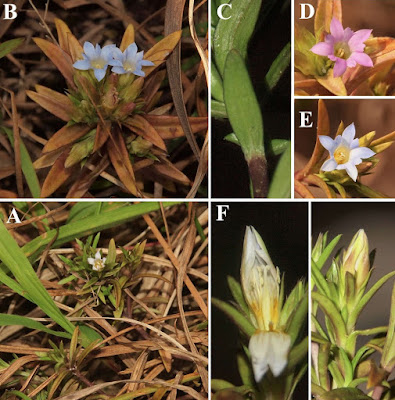[Most Recent Entries] [Calendar View]
Tuesday, July 30th, 2019
| Time | Event | ||||
| 6:08a | [Entomology • 2019] Sinopyrophorus schimmeli • Sinopyrophorinae, A New Subfamily of Elateridae (Coleoptera, Elateroidea) with the First Record of A Luminous Click Beetle in Asia and Evidence for Multiple Origins of Bioluminescence in Elateridae
Abstract The new subfamily Sinopyrophorinae within Elateridae is proposed to accommodate a bioluminescent species, Sinopyrophorus schimmeli Bi & Li, gen. et sp. nov., recently discovered in Yunnan, China. This lineage is morphologically distinguished from other click-beetle subfamilies by the strongly protruding frontoclypeal region, which is longitudinally carinate medially, the pretarsal claws without basal setae, the hind wing venation with a well-defined wedge cell, the abdomen with seven (male) or six (female) ventrites, the large luminous organ on the abdominal sternite II, and the male genitalia with median lobe much shorter than parameres, and parameres arcuate, with the inner margin near its apical third dentate. Molecular phylogeny based on the combined 14 mitochondrial and two nuclear genes supports the placement of this taxon far from other luminescent click-beetle groups, which provides additional evidence for the multiple origin of bioluminescence in Elateridae. Illustrations of habitus and main diagnostic features of S. schimmeli Bi & Li, gen. et sp. nov. are provided, as well as the brief description of its luminescent behavior. Keywords: China, mitochondrial genome, molecular phylogeny, new genus, new species, taxonomy
Taxonomy Sinopyrophorus Bi & Li, gen. nov. = Sinopyrophorus He et al., 2019: 565 [nomen nudum; published without description, unavailable name according to the ICZN (1999, Art. 13)]. Type species: Sinopyrophorus schimmeli Bi & Li, sp. nov., here designated. Diagnosis: Head with frontoclypeal region (Fig. 4) strongly protruding, longitudinally strongly carinate medially; antennomeres II and III short, subequal in length; clicking mechanism (i.e., prosternal process fitting into mesoventral cavity) fully developed; prosternal process straight in lateral view, pretarsal claw (Fig. 13) lacking setae at base; hind wing (Fig. 14) with well-defined wedge cell; abdomen with seven (male) or six (female) ventrites; large transverse luminous organ present on abdominal sternite II (Fig. 16); aedeagus (Fig. 20) with parameres arcuate and median lobe much shorter than parameres. Etymology: The generic name is derived from the Latin prefix sino-, which means Chinese, and Pyrophorus, a bioluminescent click-beetle genus from Central and South America. Gender masculine. Distribution: China: Western Yunnan. Sinopyrophorus schimmeli Bi & Li, sp. nov. Etymology: This species is named in honor of late Mr. Rainer Schimmel, a specialist in Elateridae, who kindly provided valuable comments at the beginning of this study. Sinopyrophorinae Bi & Li, subfam. nov. Type genus: Sinopyrophorus Bi & Li, gen. nov., here designated. Diagnosis: The molecular phylogenetic analysis (Fig. 1) and morphology (Figs 2–23) justify the establishment of a new monogeneric subfamily Sinopyrophorinae Bi & Li, subfam. nov. within Elateridae. Sinopyrophorinae are easily recognizable by the strongly protruding frontoclypeal region (Fig. 4), which is medially distinctly longitudinally carinate, antennomeres II and III subequal in length and together less than half as long as antennomeres IV–XI, pronotal hind angles (Fig. 8) acute, produced posterolaterally, prosternal process (Fig. 8c) straight in lateral view, tarsomeres III and IV (Fig. 12) with ventral lobes, abdomen with seven (male) or six (female) ventrites, with a luminous organ (Fig. 16) on sternite II, and aedeagus (Fig. 20) with a median lobe shorter than phallobase, and arcuate parameres. Wen-Xuan Bi, Jin-Wu He, Chang-Chin Chen, Robin Kundrata and Xue-Yan Li. 2019. Sinopyrophorinae, A New Subfamily of Elateridae (Coleoptera, Elateroidea) with the First Record of A Luminous Click Beetle in Asia and Evidence for Multiple Origins of Bioluminescence in Elateridae. ZooKeys. 864: 79-97. DOI: 10.3897/zookeys.864.26689 The first bioluminescent click beetle discovered in Asia represents a new subfamily bit.ly/30PbABV via @Pensoft @EurekAlert | ||||
| 12:05p | [Botany • 2019] Gentiana bolavenensis (Gentianaceae) • A New Species from Dong Hua Sao National Protected Area in southern Laos
ABSTRACT A new species of Gentiana, Gentiana bolavenensis (Gentianaceae) is described from Dong Hua Sao National Protected Area in southern Laos, with photographs, a vernacular name and a preliminary conservation status. KEYWORDS: Bolaven Plateau, flora, Gentianales, Indochina, taxonomy Gentiana bolavenensis Nagah., Tagane & Soulad., sp. nov. Gentiana bolavenensis is similar to G. ting-nung-hoae Halda and G. laotica, but differs from the former in having a larger size (9.5–18.3 cm tall in G. bolavenensis vs. 1–7(–10) cm tall in G. ting-nung-hoae), longer calyx tube and lobes (calyx tube 4 mm long, lobes 6–7 mm long, vs calyx tube 2.5 mm, lobes 2–3 mm long, respectively), longer stamens (ca 6 mm long vs 4–4.5 mm long) and shorter stigma (1 mm long vs 2–2.5 mm long), and from the latter in having light pale blue or pale purple corolla (vs whitish in G. laotica) and lanceolate, narrowly elliptic,oblanceolate leaves (vs obovate to obovate-oblong in G. laotica) Etymology.— The specific epithet refers to the Bolaven Plateau where we collected the plant. Distribution.— Laos (so far known only from Dong Hua Sao National Protected Area; Fig. 1). Ecology.— Three small populations each consisting of ca 20–30 individuals were found in the open grasslands on the top of Bolaven Plateau, at altitudes of 1,239 m, 1,260 m and 1,268 m (Fig. 2). From the latter two, we collected the above specimens. Vernacular name.— Wheed Bolaven (ຫວີດບໍລະເວນ) (suggested here). Ai Nagahama, Shuichiro Tagane, Phetlasy Souladeth, Anousone Sengthong and Tetsukazu Yahara. 2019. Gentiana bolavenensis (Gentianaceae), A New Species from Dong Hua Sao National Protected Area in southern Laos. Thai Forest Bulletin (Botany). 47(2), 133-136. DOI: 10.20531/tfb.2019.47.2.02 |
| << Previous Day |
2019/07/30 [Calendar] |
Next Day >> |






